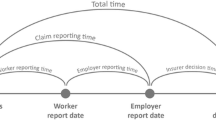Abstract
Objective
To determine the risk factors associated with early repeat workers’ compensation claims in Victoria, Australia and to compare our findings with those of a study on the Alberta’s Workers’ Compensation Board (WCB) in Canada.
Methods
We reviewed and described 178,630 claims from 1996–2009. Both persons with single and persons with multiple claims were included. Survival analysis was used to determine the impact of socio-demographic factors on the time between claims.
Results
A total of 37% of persons with an initial claim lodged a second claim. A reduced time to a second claim was observed in younger males in the manufacturing industry. Earlier second claims were more common in workers exposed to mental stress, sound and pressure, or chemical and other substances. These findings are similar to those of WCB Alberta.
Conclusion
There is a potential to reduce the socio-economic burden of workplace injury in both jurisdictions by enacting prevention programs targeted at workers with an increased risk of repeat claims.
Résumé
Objectif
Déterminer les facteurs de risque associés aux demandes d’indemnisation d’accidents du travail répétées à brève échéance dans l’État de Victoria (Australie) et comparer nos résultats avec ceux d’une étude sur la Commission des accidents du travail (CAT) de l’Alberta (Canada).
Méthode
Nous avons examiné et décrit 178 630 demandes présentées entre 1996 et 2009. Nous avons inclus les demandeurs uniques et les personnes ayant présenté plusieurs demandes. À l’aide d’une analyse de survie, nous avons déterminé l’effet des facteurs sociodémographiques sur le délai entre les demandes.
Résultats
Trente-sept p. cent des personnes ayant fait une demande d’indemnisation initiale en ont présenté une seconde. Un délai réduit entre la première et la seconde demande a été observé chez les jeunes hommes travaillant dans le secteur manufacturier. Une seconde demande à brève échéance était plus courante chez les travailleurs exposés au stress mental, au bruit et à la pression, ou aux produits chimiques et autres substances. Ces constatations sont semblables à celles de la CAT de l’Alberta.
Conclusion
Il serait possible de réduire le fardeau socioéconomique des accidents du travail dans l’État de Victoria et en Alberta en adoptant des programmes de prévention axés sur les travailleurs les plus susceptibles de présenter des demandes répétées.
Similar content being viewed by others
References
Johnson D, Fry T. Factors affecting return to work after injury: A study for the Victorian WorkCover authority. Melbourne Institute Working Paper. Melbourne, Australia: Melbourne Institute of Applied Economic and Social Research, The University of Melbourne, 2002.
WorkSafe. WorkSafe Victoria Annual Report 2010. Melbourne: WorkSafe Victoria, 2010.
Cherry N, Sithole F, Beach J, Burstyn I. Second WCB claims: Who is at risk? Can J Public Health 2010;101(Suppl.1):S53–S57.
Ruseckaite R, Collie A. Repeat workers’ compensation claims: Risk factors, costs and work disability. BMC Public Health 2011;11:492.
Lipscomb H, Cameron W, Silverstein B. Incident and recurrent back injuries among union carpenters. Occup Environ Med 2008;65:827–34.
Gross D, Battie M. Predicting timely recovery and recurrence following mul-tidisciplinary rehabilitation in patients with compensated low back pain. Spine 2005;30:235–40.
Anema J, Schellart A, Cassidy J, Loisel P, Veerman T, Van der Beek A. Can cross country differences in return-to-work after chronic occupational back pain be explained? An explanatory analysis on disability policies in a six country cohort study. J Occup Rehabil 2009;19:419–26.
Yassi A, Gilbert M, Cvitkobvich Y. Trends in injuries, illnesses, and policies in Canadian healthcare workplaces. Can J Public Health 2005;96:333–39.
Type of Occurrence Classification System, 3rd edition (revision 1). Canberra, Australia: Australian Safety and Compensation Council, Australian Government, 2008.
ANZSCO — Australian and New Zealand Standard Classification of Occupations. Canberra: Australian Bureau of Statistics, 2006.
Driscoll T, Hendrie L. Surveillance of work-related disorders in Australia using general practitioner data. Aust N Z J Public Health 2002;26:346–51.
Collie A, Pan Y, Britt H, Henderson J. Coverage of work-related injuries by workers’ compensation in Australian general practice. BMC Public Health 2011; submitted.
Author information
Authors and Affiliations
Corresponding author
Additional information
Acknowledgements: Funding for this project was provided by a research grant from WorkSafe Victoria.
Conflict of Interest: None to declare.
Rights and permissions
About this article
Cite this article
Ruseckaite, R., Clay, F.J. & Collie, A. Second Workers’ Compensation Claims: Who Is At Risk? Analysis of WorkSafe Victoria, Australia Compensation Claims. Can J Public Health 103, e309–e313 (2012). https://doi.org/10.1007/BF03404241
Received:
Accepted:
Published:
Issue Date:
DOI: https://doi.org/10.1007/BF03404241




